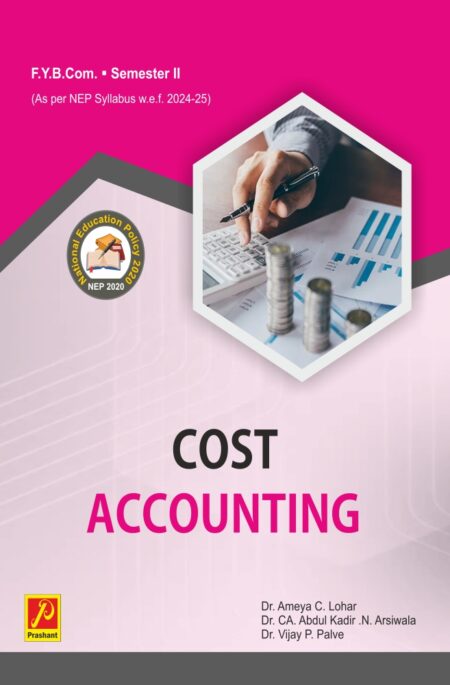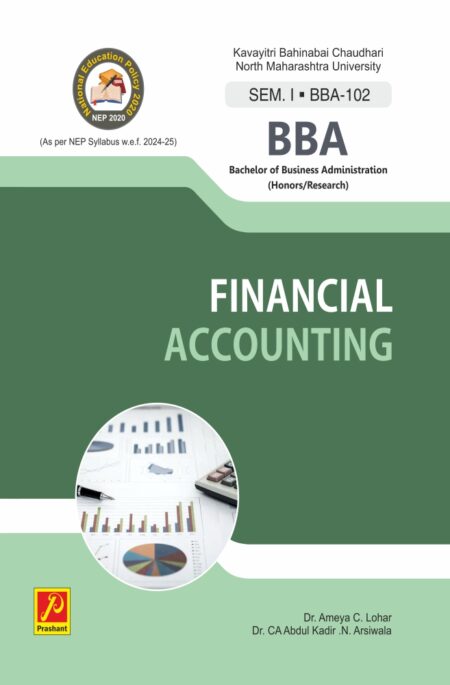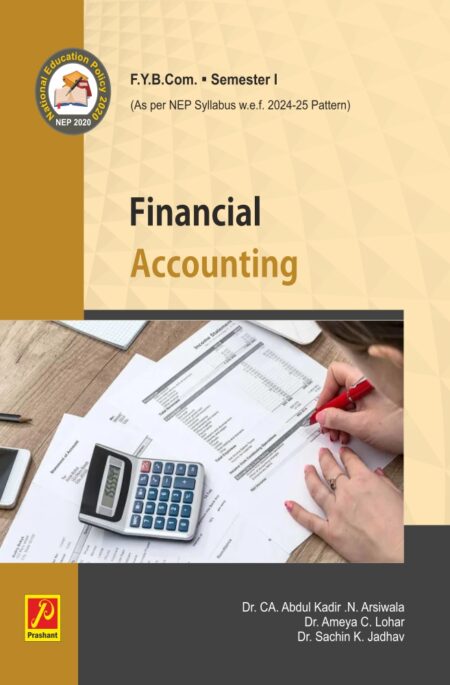-

-

-

Advanced Accountancy – IV
₹165.00We have great pleasure in presenting the text book on Advanced Accountancy for M.Com Semester IV students of KBC North Maharashtra University. The book has been written in student friendly approach, each chapter contains sufficient theory to acquire a through understanding of the concepts. This book delivers into the intricate world of audits, providing valuable insights and practical knowledge to auditors, professionals, and students alike. Through a series of lectures, we explore the audit procedures, regulations, and reporting requirements specific to different industries.
Unit 1 focuses on the audit of banks, encompassing the salient features of relevant enactments and the approach to bank audit. We examine the verification of assets and liabilities, including cash, investments, loans, and non-performing assets. Additionally, we delve into the audit of income and expenses, profit transfers, and dividends. In Unit 2, we shift our attention to th e audit of co-operative societies, analyzing the unique features and provisions outlined in the Maharashtra State Co-operative Societies Act. We explore the intricacies of auditing co-operative societies and discuss the essential components of an audit report for such entities. Unit 3 explores the audit procedures specific to specialized units such as hospitals, hotels, cinema halls, and hire-purchase and leasing companies. We delve into the distinct aspects of auditing each of these entities and highlight the key considerations and procedures to ensure effective audits. Unit 4 introduces the concept of Information System Auditing (IS Auditing) and emphasizes the need for auditing information systems. We cover the objectives, planning process, and evaluation of controls in an information system audit, including management controls, operational controls, organizational controls, and application controls. Unit 5 delves into the realm of management audit, providing an understanding of its nature, objectives, scope, and importance. We discuss the merits and limitations of management audit, drawing a clear distinction between management audit and statutory audit. Furthermore, we explore the qualifications, duties, and role of a management auditor, along with guidelines for drafting reports that enhance managerial effectiveness. Finally, in Unit 6, we unravel the intricacies of preparing audit reports for limited companies. We examine the contents and requirements of audit reports as mandated by the Companies Act, Companies (Audit and Auditors) Rules, and the CARO 2016. We also explore the nature of opinions expressed by auditors and the significance of notes to accounts about study of SA 700 and SA 800. -

-

-

Cost Accounting
₹115.00Cost Accounting plays a vital role in commerce education, providing essential knowledge for students to understand cost management in businesses. This book, Cost Accounting – Semester II, is designed to meet the academic needs of F.Y. B.Com students. It covers both theoretical and practical aspects, making complex concepts easy to grasp.
The syllabus is divided into six units, each focusing on a specific area of cost accounting:
Unit 1: Introduction to Cost Accounting This unit explains the meaning, objectives, importance, and limitations of cost accounting. It also covers key concepts like cost, expenses, loss, costing, cost unit, and cost centre, along with factors to consider for installing a cost accounting system.
Unit 2: Elements of Cost Students will learn about the three main elements of cost: material, labour, and overheads. The unit emphasizes the classification and principles of overheads, providing clarity on how costs are categorized and managed.
Unit 3: Preparation of Cost Sheet This unit focuses on the preparation of cost sheets to determine the total cost and profit of products or services. It covers the meaning, nature, advantages, and practical problems related to cost sheets.
Unit 4: Material Cost The fourth unit delves into material classification, purchasing methods, and procedures for storage and issuance. It also covers handling material losses such as wastage, scrap, and spoilage, and explains methods of material costing like FIFO, LIFO, and average methods.
Unit 5: Labour Cost This unit introduces the concept of labour and wages, including labour classification and wage payment methods like time rate and piece rate systems (Halsey and Rowan plans), helping students understand labour cost management.
Unit 6: Overheads Cost The final unit explains overhead costs, covering allocation, apportionment, and distribution of overheads. It also discusses re-apportionment of service department costs, which is crucial in cost management.
We trust that both students and educators will find this book immensely beneficial. While every effort has been made to ensure accuracy and clarity, we acknowledge the possibility of inadvertent errors. We extend our heartfelt gratitude to our families for their unwavering support and encouragement throughout this endeavor. -

Financial Accounting
₹225.00Financial Accounting is crucial for understanding how businesses manage money by recording, summarizing, and analyzing transactions. It helps businesses track income and expenses, providing insights into profitability and financial health. Key concepts include journals, ledgers, trial balances, and financial statements like profit and loss accounts and balance sheets. This knowledge is valuable for businesses, individuals managing personal finances, and students pursuing careers in commerce, management, and accounting. It ensures transparency and accountability, allowing businesses to communicate with stakeholders such as investors, banks, and the government.
-

Financial Accounting
₹150.00It is well said that ‘change is the only permanent thing in this world’. Therefore, any change in the curriculum of a subject is part of the natural process of development. Advancement in knowledge is possible only if a subject is taught and learned differently at different times. Since KBC North Maharashtra University is adopting a New Education Policy for First Year Students of Bachelor of Commerce, it is our duty to present the necessary learning material to them.
We are pleased to present the textbook on ‘Financial Accounting’ for F.Y.B.Com. students. It has been written in a teach-yourself style, following a student-friendly approach. Sufficient theory content and numerous examples covering all typical points are given. Illustrations in the book include questions from KBC NMU and other university examinations. Topics are arranged exactly according to the new syllabus.
The syllabus is divided into six units, each designed to provide a thorough understanding of key accounting principles and practices. Unit 1 covers the theoretical framework, including valuation principles, accounting estimates, and the scope of GAAP, Ind AS, and IFRS. Unit 2 focuses on the preparation of financial statements, such as the Trading and Profit & Loss Account, and the Balance Sheet, along with practical numerical problems. Unit 3 deals with the accounts of non-profit organizations, guiding students through the preparation of Receipts and Payment Accounts, Income and Expenditure Accounts, and Balance Sheets. Unit 4 explains the gradual realization and piecemeal distribution of cash on the dissolution of a partnership firm, including methods like the maximum loss method and the highest relative capital method. Unit 5 explores the conversion of a partnership firm into a limited company, detailing the meaning, need for conversion, calculation of purchase consideration, and closing entries. Finally, Unit 6 delves into joint venture accounting, distinguishing between joint ventures and partnerships, and outlining the accounting procedures for joint venture transactions when separate books are maintained. -

-

-

